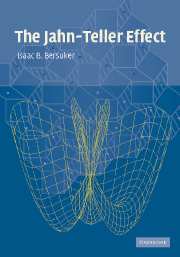Book contents
- Frontmatter
- Contents
- Preface
- Abbreviations
- 1 Introduction
- 2 Vibronic interactions
- 3 Formulation of Jahn–Teller problems. Adiabatic potentials
- 4 Pseudo Jahn–Teller, product Jahn–Teller, and Renner–Teller effects
- 5 Solutions of vibronic equations. Energy spectra and JT dynamics
- 6 The JTE in spectroscopy: general theory
- 7 Geometry, spectra, and reactivity of molecular systems
- 8 Solid-state problems: local properties and cooperative phenomena
- Appendix
- Subject index
- Formula index
5 - Solutions of vibronic equations. Energy spectra and JT dynamics
Published online by Cambridge University Press: 07 December 2009
- Frontmatter
- Contents
- Preface
- Abbreviations
- 1 Introduction
- 2 Vibronic interactions
- 3 Formulation of Jahn–Teller problems. Adiabatic potentials
- 4 Pseudo Jahn–Teller, product Jahn–Teller, and Renner–Teller effects
- 5 Solutions of vibronic equations. Energy spectra and JT dynamics
- 6 The JTE in spectroscopy: general theory
- 7 Geometry, spectra, and reactivity of molecular systems
- 8 Solid-state problems: local properties and cooperative phenomena
- Appendix
- Subject index
- Formula index
Summary
The main effects of JT vibronic couplings are due to the special dynamics of the nuclear configuration that follows from the JT instability. The energy levels and wavefunctions describing these effects are solutions of the system of coupled equations (2.6) in Section 2.1. They were obtained for the most important JT problems formulated in Chapters 3 and 4, and are discussed in this chapter.
Weak vibronic coupling, perturbation theory
Calculation of the energy spectrum and wavefunctions of a JT or PJT molecule as solutions of the coupled equations (2.6) is a very complicated problem which cannot be solved in a general form, without simplifications, for arbitrary systems. However, as in similar quantum-mechanical situations, analytical solutions for some limiting cases in combination with exact numerical solutions of some particular cases yield the general trends and provide understanding of the origin and mechanism of the phenomenon as a whole.
For vibronic problems the limiting cases of weak and strong vibronic coupling with relatively small and large vibronic coupling constants, respectively, can be solved analytically. A quantitative criterion of weak and strong coupling can be defined by comparing the JT stabilization energy with the zero-point energy of -fold degenerate vibrations. Denote. Then, if, the vibronic coupling will be regarded as weak, and if λΓ ≫ 1, the coupling is strong; λΓ is the dimensionless vibronic coupling constant.
- Type
- Chapter
- Information
- The Jahn-Teller Effect , pp. 162 - 262Publisher: Cambridge University PressPrint publication year: 2006

